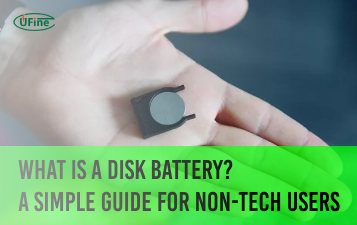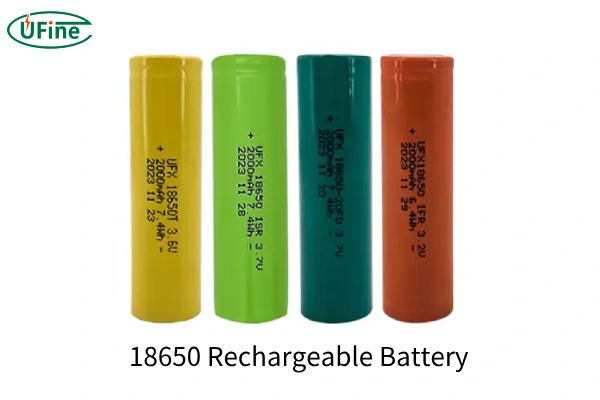Choosing the right rechargeable battery can be daunting, especially with options like 26650 and 18650 batteries available. But which one is right for you? This comprehensive guide will delve into everything you need to know about these two popular battery types. By the end, you’ll clearly understand their differences, and similarities, and which battery is better suited for your needs.
Part 1. 18650 and 26650 rechargeable battery overview
What is the 26650 Rechargeable Battery?
A 26650 rechargeable battery is a type of lithium-ion battery known for its high capacity and robust performance. The name “26650” comes from its dimensions: 26mm in diameter and 65mm in length. These batteries are favored for their excellent energy storage capabilities, making them ideal for high-drain devices such as powerful flashlights, electric vehicles, and certain types of power tools. The substantial capacity of 26650 batteries means they can last longer between charges, which is a critical advantage in demanding applications.
What is the18650 Rechargeable Battery?
Similarly, a 18650 rechargeable battery is a lithium-ion battery, but it is slightly smaller, measuring 18mm in diameter and 65mm in length. The 18650 battery is highly versatile and widely used across various consumer electronics, including laptops, vape devices, and portable power banks. One of the key benefits of 18650 batteries is their balance between size, capacity, and performance, making them a popular choice for many everyday applications. Their widespread use also means they are readily available and relatively affordable.
Part 2.Parameter comparison
1. Chemical Materials
- 26650: These batteries often use advanced chemistries such as Lithium Nickel Manganese Cobalt Oxide (NMC) or Lithium Iron Phosphate (LiFePO4). These materials provide high energy density and stability, which are crucial for high-drain applications.
- 18650: Commonly, 18650 batteries utilize Lithium Cobalt Oxide (LCO) or Lithium Manganese Oxide (LMO). These chemistries offer a good balance of capacity, safety, and cost, making them suitable for a broad range of applications.
2. Voltage
- 26650: Typically, 26650 batteries have a nominal voltage of 3.6V or 3.7V, similar to other lithium-ion batteries. This voltage is ideal for high-power devices.
- 18650: These batteries also usually have a nominal voltage of 3.6V or 3.7V, making them compatible with many electronic devices that require this standard voltage.
3. Capacity
- 26650: Known for their high capacity, 26650 batteries range from 3000mAh to 5200mAh. This high capacity allows for longer usage times between charges, which is beneficial for high-drain devices.
- 18650: These batteries typically have capacities ranging from 350mAh to 3500mAh. While lower than 26650 batteries, this capacity is often sufficient for many portable electronics and everyday devices.
4. Discharge Rate
- 26650: Generally, 26650 batteries have a higher discharge rate, making them suitable for devices that require a lot of power quickly, such as power tools and high-lumen flashlights.
- 18650: These batteries offer a moderate discharge rate, which is adequate for most consumer electronics but may not be sufficient for very high-drain applications.
5. Size
- 26650: With a diameter of 26mm and a length of 65mm, these batteries are larger and bulkier, which can be a consideration for device design and portability.
- 18650: Measuring 18mm in diameter and 65mm in length, 18650 batteries are more compact and easier to incorporate into a wide variety of devices.
6. Weight
- 26650: Typically, these batteries are heavier, weighing around 90-100 grams. The added weight is due to their larger size and higher capacity.
- 18650: These batteries are lighter, usually weighing between 45-50 grams, making them ideal for portable devices where weight is a critical factor.
7. Application
- 26650: These are ideal for high-drain devices such as powerful flashlights, electric vehicles, and power tools that require sustained high power over longer periods.
- 18650: These versatile batteries are commonly found in laptops, vape devices, portable power banks, and other consumer electronics where compact size and moderate power are sufficient.
8. Price
- 26650: Generally, 26650 batteries are more expensive due to their higher capacity and larger size. The cost can be a significant factor if you need multiple batteries for high-drain applications.
- 18650: These batteries tend to be more affordable and are widely available, making them a cost-effective choice for many everyday devices.
9. Charger
- 26650: Due to their larger size and higher capacity, 26650 batteries require chargers that are specifically designed to handle their dimensions and charging requirements. These chargers may be less common and slightly more expensive.
- 18650: Chargers for 18650 batteries are more readily available and often less expensive. They are widely used, which means you can easily find compatible chargers in the market.
Part 3. 26650 vs 18650 rechargeable battery: differences
Here’s a table summarizing the key differences between 26650 and 18650 batteries:
| Feature | 26650 rechargeable battery | 18650 rechargeable battery |
|---|---|---|
| Diameter | 26mm | 18mm |
| Length | 65mm | 65mm |
| Capacity | 3000mAh – 5200mAh | 350mAh – 3500mAh |
| Weight | 90-100 grams | 45-50 grams |
| Discharge Rate | Higher | Moderate |
| Application | High-drain devices | Versatile |
| Price | More expensive | More affordable |
| Charger | Specific to 26650 | Specific to 18650 |
Part 4. 26650 vs 18650 rechargeable battery: similarities
Despite their differences, 26650 and 18650 batteries share several similarities. Here’s a table highlighting these commonalities:
| Feature | 26650 rechargeable battery | 18650 rechargeable battery |
|---|---|---|
| Voltage | 3.6V / 3.7V | 3.6V / 3.7V |
| Chemistry | Li-ion | Li-ion |
| Rechargeable | Yes | Yes |
| Lifespan | Typically 300-500 cycles | Typically 300-500 cycles |
| Safety Features | Built-in protection circuits | Built-in protection circuits |
Part 5. 26650 vs 18650 Rechargeable Battery: Which One is Better?
Determining whether a 26650 or an 18650 battery is better depends largely on your specific needs and applications.
- Choose 26650 rechargeable battery if: You need a battery for high-drain devices that require long-lasting power and can accommodate the larger size and weight. These batteries are excellent for applications like powerful flashlights, electric vehicles, and power tools.
- Choose 18650 rechargeable battery if: You need a versatile battery that is compact, lightweight, and cost-effective. These batteries are suitable for a wide range of consumer electronics, including laptops, vape devices, and portable power banks.
In conclusion, both 26650 and 18650 batteries have their unique advantages. Understanding their specifications and how they align with your device requirements will help you make an informed decision. Whether you prioritize capacity, size, or cost, there’s a rechargeable battery out there that will meet your needs perfectly.
Part 6. FAQs
-
Can I use 18650 and 26650 batteries interchangeably?
No, the different physical sizes of 18650 and 26650 batteries mean they are not interchangeable. Devices are designed specifically for one battery size. -
How long do 18650 and 26650 batteries last?
Typically 300-500 charge cycles, depending on usage and maintenance. -
Can I use a 26650 battery in place of an 18650 battery?
It’s not recommended unless your device is designed to accommodate both sizes. -
Are there safety concerns when using 18650 and 26650 batteries?
Like any lithium-ion battery, proper handling and charging practices are essential to prevent overheating and potential hazards.
Related Tags:
More Articles

What Is a Disk Battery? A Simple Guide for Non-Tech Users
A disk battery is a small, round cell used in watches, remotes, and other electronic devices. It delivers steady power for compact, low-drain devices.
What Battery Powers a Space Heater?
Discover the type of battery that powers space heaters and learn how to choose the right one for efficient heating in your home or office.
What Is an LR14 Battery? Learn About This C-Size Cell
The LR14 battery, also known as a C battery, delivers steady power. Learn its specs, uses, lifespan, and how it compares to other battery types.
Watch Battery Dimensions Chart: Sizes, Voltages, and Equivalents Explained
Understanding watch battery dimensions helps you choose the right size, voltage, and equivalent model to keep your watch running safely and smoothly.
How Long Can You Rely on Battery-Powered Generators?
Discover battery generator runtime & lifespan factors. Learn how to maximize performance and choose the right power solution.






